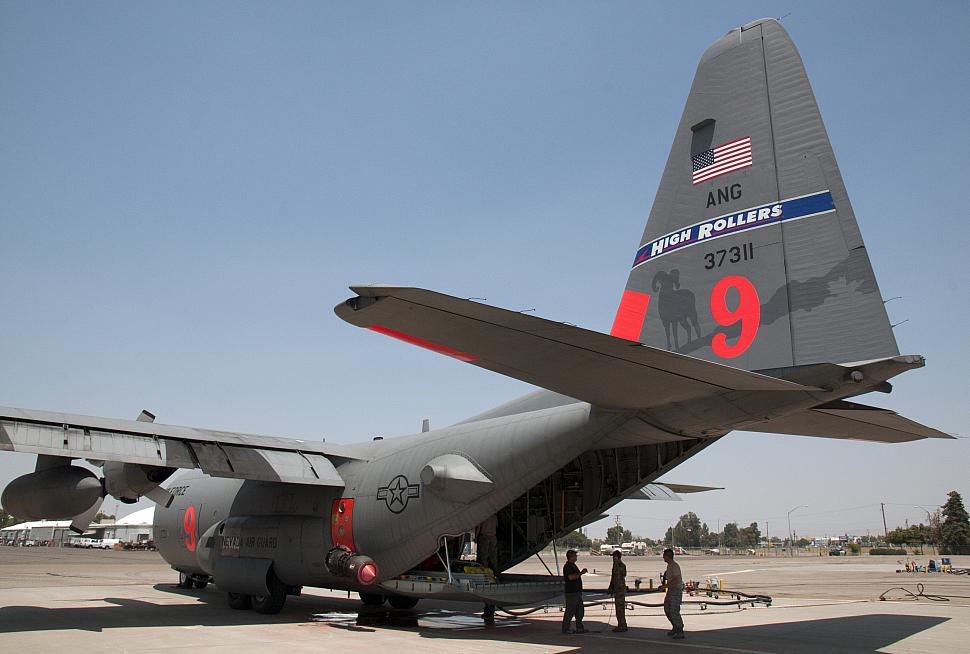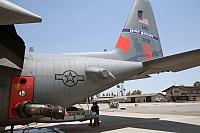C-130 News
C-130 Hercules News
High Rollers deploy for first MAFFS activation
July 26, 2017 (by
TSgt. Timothy Emerick) -
More than a year after being named the newest military C-130 unit equipped with the Modular Airborne Fire Fighting System, the 152nd Airlift Wing flew its first firefighting operation Saturday at the Fresno Air Attack Base in support of the U.S. Forest Service.

"It's awesome. It's great to have our tail out there," said Lt. Col. Anthony Machabee, 152nd Operations Group Commander. "Our crews, maintenance, the pilots, loadmasters, engineers -- it's kind of surreal. The 152nd is in the business of fighting fires."
Additionally, two C130J aircraft from the 146th Airlift Wing, Port Hueneme, California, have been operating out of the same location in support of CAL FIRE.
Crew chiefs, logistics and operations personnel and members of the Fresno Air Attack Base's fire service team watched from a distance as the 152nd's C-130H, equipped with MAFFS, taxied toward its first firefighting operation over the Detwiler Fire. As of Tuesday, the fire had burnt nearly 76,500 acres and threatened 1,500 structures, including 63 residences. It began July 16.
"This is the first time the Nevada Air Guard has been tasked as the active lead unit," said Master Sgt. Jennifer Harrell, a 152nd crew chief. "Being out here is a big deal for us."
Harrell was one of only nine crew chiefs and six aircrew members initially activated for this operation. A MAFFS instructor loadmaster and an instructor pilot from the 153rd Airlift Wing, Wyoming National Guard, were additionally tasked to deploy here in support of the 152nd's MAFFS firefighting operation, given this is the first year the 152nd has activated with its own aircraft.
A seasoned crew chief, Harrell played an important role in ensuring MAFFS 9 remained deployable.
This operation was not only the first of the day for MAFFS 9, one of only two MAFFS configured aircraft stationed at the Nevada Air National Guard Base in Reno. It was MAFFS 9's maiden flight as an active support aircraft working with U.S.F.S.
"My tasking, as the crew chief, is to ensure the aircraft remains perfectly inspected and flyable and to coordinate any additional maintenance that may need to be performed," she said. "At the end of the day we recover the aircraft, do a full inspection, a rinse to ensure the retardant hasn't affected the aircraft and then we make sure the aircraft is ready for the next day's mission."
Maintaining the aircraft's structural and surface integrity can be a challenging task for maintainers, Harrell said.
"The retardant is incredibly corrosive," she said. "So, we need to make sure the aircraft is at its best flying capability because this is a very intense mission."
The crew flew two successful sorties, or flying operations, over the Detwiler Fire, which saw its containment jump from 20 percent to 40 percent Saturday night. They flew an additional seven sorties on Monday and remain at Fresno Air Attack Base this week in support of the U.S. Forest Service's firefighting operation.

USAF C-130H3 #93-7311 from 192 AS receives retardant at the Fresno Air Attack Base flightline to fire lines in the Sierra. This "after" photo is of the first ever 152nd AW retardant drop with one of its own aircraft on July 22, 2017. [Photo by TSgt. Emerson Marcus]
Additionally, two C130J aircraft from the 146th Airlift Wing, Port Hueneme, California, have been operating out of the same location in support of CAL FIRE.
Crew chiefs, logistics and operations personnel and members of the Fresno Air Attack Base's fire service team watched from a distance as the 152nd's C-130H, equipped with MAFFS, taxied toward its first firefighting operation over the Detwiler Fire. As of Tuesday, the fire had burnt nearly 76,500 acres and threatened 1,500 structures, including 63 residences. It began July 16.
"This is the first time the Nevada Air Guard has been tasked as the active lead unit," said Master Sgt. Jennifer Harrell, a 152nd crew chief. "Being out here is a big deal for us."
Harrell was one of only nine crew chiefs and six aircrew members initially activated for this operation. A MAFFS instructor loadmaster and an instructor pilot from the 153rd Airlift Wing, Wyoming National Guard, were additionally tasked to deploy here in support of the 152nd's MAFFS firefighting operation, given this is the first year the 152nd has activated with its own aircraft.
A seasoned crew chief, Harrell played an important role in ensuring MAFFS 9 remained deployable.
This operation was not only the first of the day for MAFFS 9, one of only two MAFFS configured aircraft stationed at the Nevada Air National Guard Base in Reno. It was MAFFS 9's maiden flight as an active support aircraft working with U.S.F.S.
"My tasking, as the crew chief, is to ensure the aircraft remains perfectly inspected and flyable and to coordinate any additional maintenance that may need to be performed," she said. "At the end of the day we recover the aircraft, do a full inspection, a rinse to ensure the retardant hasn't affected the aircraft and then we make sure the aircraft is ready for the next day's mission."
Maintaining the aircraft's structural and surface integrity can be a challenging task for maintainers, Harrell said.
"The retardant is incredibly corrosive," she said. "So, we need to make sure the aircraft is at its best flying capability because this is a very intense mission."
The crew flew two successful sorties, or flying operations, over the Detwiler Fire, which saw its containment jump from 20 percent to 40 percent Saturday night. They flew an additional seven sorties on Monday and remain at Fresno Air Attack Base this week in support of the U.S. Forest Service's firefighting operation.
Courtesy of 152 Airlift Wing/Public Affairs
Related articles:
Forum discussion:
Tags
- Guard, Reserve units complete annual firefighting training with U.S. Forest Service (2017-04-24)
- Guard & Reservists provide surge support to Great Basin fires (2016-09-23)
- 'High Rollers' complete first MAFFS activation (2016-09-09)
- Reserve C-130s called up to fight wildland fires (2015-08-03)
- C-130 Fighting Falcon news archive
Forum discussion:
- Start a discussion about this article in the C-130.net forum.
Tags
Additional images:

USAF C-130H3 #93-7311 from 192 AS receives retardant at the Fresno Air Attack Base in Fresno, California after a drop on the Detwiler Fire on July 22, 2017. The 152nd Airlift Wing, Nevada Air National Guard, became the newest Department of Defense military unit to use the U.S. Forest Service's MAFFS last year. After getting certified with other aircrew in 2016. [photo by TSgt. Emerson Marcus]
